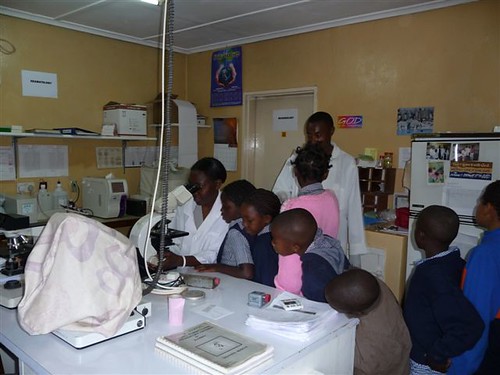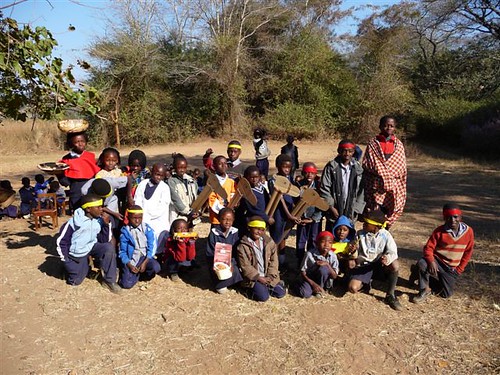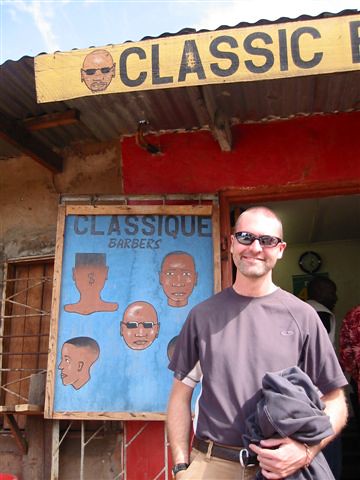Thursday, July 31, 2008
secondhand best
instead of throwing something away or giving it to Goodwill, you instead
sent it overseas for a missionary to sort out and use. Thankfully, that
concept has largely died, but it still holds true from time to time when
it comes to medical supplies -- send the expired stuff, the odd-sized
things, the rehabilitated or too antiquated equipment out to the field.
(Before I came, I was reading that Africa now has a waste disposal
problem because of the sheer number of antiquated or even
non-functioning computers that are sent out; apparently they contain
some kind of hazardous chemical inside which my 2 foot deep trash pit in
the backyard isn't quite adequate for.) Unfortunately, our patients and
doctors aren't particularly odd-sized (or expired for that matter!) so
we have an entire shelf in the storeroom full of size 9.0 and 5.5
surgical gloves! (that's really big and really small if you're non-medical)
We've been blessed with recent donations to cover the purchase of a
brand-new anesthesia machine for the hospital which will allow us to
give safe gas anesthesia to our patients at the hospital; saving us
money, providing for a safer anesthesia, and allowing us to treat
patients more effectively that we used to be able to. It's unusual that
something brand-new comes from donations and it got me stirred up again
about why we settle for less than the best when it comes to the work
that we are doing here. Don't get me wrong, we do our absolute best
with what we are provided with -- work extra hours, fill in the gaps,
trust in God to make up the difference -- but you get demoralized
because you know that your 100% effort is limited to say, 70%
effectiveness, because of the circumstances that are around you.
I was reading about the miracle at Cana and the fact that the wine that
Jesus made was 'the best wine'. Even though it would be 'wasted' on the
already drunk guests, it was still worthwhile to produce something that
would be the best to him. The difference between offering what could be
the best wine instead of watered down grape juice often lies outside of
myself and my control -- on the supplies from the government, the
donations of strangers -- and it's been really beautiful when the church
has recognized that responsibility and stepped up to fill the
difference. It's been one of the joys of being here to see that gap
slowly closed, little by little, with help from outside ourselves here.
It's very good when we can truly offer 'the best' to those who come
looking for our help.
Sunday, July 27, 2008
hearts and chicken feet
FROM MATT:
We had a gift from the academy this week as Hilary got the kids to draw
pictures for us and gave them to us at prayer meeting. Now in general,
I'm not a big kids' picture fan -- random scribblings don't inspire me
to clear off my refrigerator and proudly display them for everyone to
see. These were a bit more amusing than the usual run of the mill
cards, however, as the combination of memory verses, favorite pictures,
and words of encouragement didn't always match up so well....
So we've got the piranhas eating the smaller fish with the encouragement
to "be kind one to another" -- good advice there.
We've got "Dear Mr. Mat, how are you? are you fine? for all have
sinned and fall short of the glory of God" (that particular verse was
very popular for almost everyone, trying to keep us humble I bet.)
We've got "Thank you for coming, even young mens will fall" -- that was
sent to the Schuberts, with three teenage boys.
So maybe I'll keep these on display for a little while longer than average.
Friday, July 25, 2008
It's time for a field trip!
Hilary: More kudos to the staff at Mukinge Hospital for
allowing us to bring the children for a “career day” field trip to the
hospital! Mabel and I walked the dusty half mile to the hospital with
our grades 3-5 students for a series of short presentations on the
different kinds of jobs found in the medical facility. Special thanks go to Dr. Edgar
Mutimushi, a Zambian physician who reminded the kids about the
importance of studying hard and showed the kids how to use a stethoscope; nurse James
Mesa, who has a winning smile and informed the kids that interior qualities
such as being kind and having a compassionate heart are important parts of
being a nurse; lab technician Paddy Chandalala who amazingly welcomed us into
the lab and let the kids look at slides through a microscope, many if not all
of them for the first time; and radiographer Kamfunte Kanyama who beautifully
explained what she does and brought along a sample X-ray for the kids to look at
firsthand.
In addition, Mr. Tantula invited us into the physiotherapy department
for a brief tour, and Uncle Gilbert explained what goes on in the outpatient
department. We also had the opportunity to walk by the pharmacy, tailor
shop, kitchen, optic shop, and nurses’ training college. Yippee for field
trips!
MHA Annual Concert and Sports Day
The Famous, the Infamous, the Lame - in your browser. Get the TMZ Toolbar Now!
Sunday, July 20, 2008
the namesake, part II
I got a chance to meet the baby named after me last weekend when we went
out to visit my host family from the village. I don't really know why I
enjoy the fact so much that there's another kid running around out there
with my name -- it's not exactly as if Matthew is an uncommon name --
but it still makes me smile. As you can see from the picture here, he's
off to a healthy (read: fat) start! As we do more of our malnutrition
outreach, I'm grateful for the kids that do at least start out fat --
they've got a leg up on the rocky road of subsistence farming ahead of them.
Friday, July 18, 2008
Three kinds of English
The Famous, the Infamous, the Lame - in your browser. Get the TMZ Toolbar Now!
Multiplication mission
The Famous, the Infamous, the Lame - in your browser. Get the TMZ Toolbar Now!
Monday, July 14, 2008
Zambian schoolhouse
Mukinge Hill Academy hosts about 70 students in grades 1-5 (British system of education), and many of the staff members at Matt's hospital choose to send their children to this academy. There are two classrooms in the building, with grade 1 in the first classroom and grades 3-5 in the other, while the grade 2 students and teacher meet in a room at the church across the road. At this current point in time, the regular headmistress/grades 3-5 teacher is on "home assignment" in the United Kingdom, so a lovely woman named Mabel from Ireland, myself until the end of this current school term, and the regular Zambian classroom assistants are handling affairs until Janet returns. I'm working mostly with the older children although we do combine all the students for some activities such as preparing for an upcoming concert/sports day.
Anyway, the schedule itself is not terribly complicated: the students bring their goal sheets to Mabel and me at the beginning of the day for a checkover, spend most of the morning engaged with their workbooks, individually check in with me, Mabel, and the other assistants in the room as they finish each assignment, and take tests when they come to the end of a particular academic unit which Mabel and I then grade that same day. The students have an early-morning break, then continue the process of working on their individual assignments along with the continual checking and grading, have a late-morning break, then do something like art, religious education, or PE in the early afternoon until the end of the school day. There are other breaks during the week for assemblies and Kikaonde (language) lessons and occasional field trips, but that's the general idea.
Anyone who has ever worked with children knows that kids are an endless source of entertainment and creativity, and the children in Zambia are certainly no exception. For our art session on Friday, I told the kids that we were going to make friendship bracelets as do many children in the United States. The idea was to make a simple bracelet with two plastic "charms" or beads on it, but in no time the kids had moved on to friendship necklaces and triple wrap bracelets, along with extras to give to family members. It's all about sharing the love :-). We spent the afternoon practicing relay races, potato sack races, and three-legged races for the upcoming sports day and concert (more on this in the near future). Lots of love to all, Hilary Burg (aka "Auntie Hilary," as the children call me :-))
The Famous, the Infamous, the Lame - in your browser. Get the TMZ Toolbar Now!
Saturday, July 12, 2008
Guest Blogger
blogging from Hilary Burg about life in the local elementary school,
Mukinge Hill Academy, where she's working for the month of July. So you
can check out blogs about about the local education scene as well!
We'll try to be fairly obvious about who's doing the blogging....
Monday, July 07, 2008
4th of July, Zambia style
It's a pleasure to be able to get back to my boyhood days of playing
with dangerous fireworks. Firework season is in December in preparation
for New Years', so it's slim pickings these days. However, I've become
more resourceful after 18 months here, so I got my chess playing contact
from the BOMA to rustle around in the shop where he works and he
uncovered two stacks of fireworks buried beneath the cartons of mchuzi
mix and Colgate toothpaste. Zambia fireworks inspire even more
nervousness that the ones I remember from childhood that would chase you
around the yard emitting green sparks: the two cartons of fireworks that
we could find had a fuse that was about 2mm long (okay, maybe that's an
exaggeration -- it was really 1mm) and were shaped suspiciously like
bullets wrapped in paper. Not knowing exactly what to expect, we found
a fairly long stick with a live coal on the end from our bonfire and had
a go -- and were rewarded with a very satisfying amount of explosion and
flashing lights shooting up into the nearby tree. Despite the fact that
we've had no rain since April, there was not even one extra fire. And
nobody's eye got put out, so I guess we met the definition of 'fun and
games'.
snake attack
in coming to visit is "what about the snakes". I've had some close
encounters with snakes since I've been here -- the time I went to the
pool to find a 6-7 foot spitting cobra swimming in the deep end; the
time I was riding my motor bike and a HUGE snake appeared out of the
grass about 10 yards in front of me -- its head had disappeared in the
grass on one side of the road before the tail appeared on the other
side; the four snakes I found on my doorstep in two weeks last
December. Remarkably, though, even if you get bitten, most people do
pretty well -- they get a big huge swollen leg that takes about a month
to go away, but there's not a lot of lasting damage.
Issues of expired drugs, unfamiliar diagnoses, and fatal diseases come
up routinely in the hospital and are part of what makes the medicine
here so challenging. This past week, we had the first severe case of
snake bite I've seen in the hospital -- a guy who was bitten 24 hours
previously and sent from one of our referring hospitals. Usually with
these severe cases of neuro toxins you expect them to die within just a
few minutes; why this man had such a delayed presentation I don't really
know (it was a 'green snake with a black head' -- more descriptive than
the usual at least, if someone wants to take a stab at identifying it).
But when he arrived at the hospital he was barely breathing and the
muscles all over his body were twitching uncontrollably. He was rapidly
accumulating fluid in his lungs because his muscles were so weak, and I
knew we didn't have much time.
Unfortunately, time was not the only thing in short supply; we have very
little snake anti-venom in the hospital, because it's expensive for us
to stock. Usually to treat a severe case of snakebite you need around
10-15 vials of anti-venom. I knew we had a hidden stash in the bottom
of the pharmacy refrigerator -- it was expired from 2004, but I had
resisted throwing it away in the hopes that it could still be useful.
Anti-venom is made from horses serum, and can be potentially dangerous
or even fatal to give if the horse serum reacts with your body. So I'm
contemplating giving a potentially dangerous drug which when it's good
can be trouble -- my batch, though, was 4 years out of date and slippery
from the mold from the bottom of the refrigerator. I've never given
this drug, or even seen anyone give it to a patient. And there's always
the chance that my diagnosis of neurotoxic snake bite could be wrong as
well, since I've never seen one of those, either.
I was surprised by our pharmacist, who reported that we had 18 of these
expired vials, about 10 more than I remembered having on hand. The man
was clearly dying, so I called in the other docs who agreed with me and
we started with 8 vials. They helped a little bit, but he was still
twitching like an electrocuted fish, so we ended up continuing to give
and give extra vials, nervously noting his wheezing with some of the
doses as he reacted to the medicine he was given. At vial #16, his
twitching finally stopped, and we ended up giving the full 18 vials to
him to make sure his symptoms didn't come back.
The next day, he's sitting up in bed, smiling, and saying he's feeling
much better! And he went home the next day after that with a slightly
swollen leg but not much the worse for wear. He also met with the
chaplains and decided to dedicate his life to God on the day he was
discharged. I can't help but think that it was unusual for him to take
24 hours to develop symptoms, to arrive at the hospital at just the
right time (an hour later he would likely have been dead), to need 18
vials to get better which just happened to be the amount that we had,
left over from some order back in 2002 or 2003, and that maybe there had
been a plan for him made a long time ago that was difficult to see until
he came.
babies in the grass
about a week ago -- this is an opportunity that everyone who works at
the hospital seems to get to enjoy at some point during their stay. I
was sitting in the maternity ward when the phone call from the girls
school came, saying someone was giving birth on the side of the road
about a kilometer away. The maternity nurse and I looked at each other,
and I offered to drive her out to the place on the back of my scooter,
so we hopped on board and zoomed at 20 kph down our rutted, dusty road
to the place where she was supposed to be. We found her sitting up in
the grass with a blanket pulled over her head and the baby on the dirt
at her feet. At this point, a small crowd had gathered, and I think she
was pretty embarrassed, so she wouldn't answer us or look out from
underneath the sheet. So we recruited about 7 women who had gathered
around to make a barrier by spreading out their skirts (the outer skirt,
not the inner one -- this isn't one of those risque stories) like a
fabric wall, at which point the young mother peeped out from underneath
her blanket and we were able to get the baby and her cleaned up. She
even agreed to be taken back to the hospital to sew up some small tears
(on the back of the motorbike, mind you -- people have to be tough here
to sit on the back of a motorcycle 20 minutes after giving birth)!
Fortunately, everyone did well and went home the next day.
Wednesday, July 02, 2008
the english cut
There's too many puns to be made on 'the first cut', but suffice it to
say that after mom and dad brought me a pair of electric clippers one of
the fun things we've been doing is offering free haircuts to the men on
male ward while they are in the hospital. I thought that maybe we'd get
one or two guys who wanted to get a shave, but it never fails that when
we do it the entire ward files up for a haircut and we're surrounded
with piles of curly hair next to the laundry lines outside. Usually I
leave the job to our capable ward assistants (Mr. Bazelel Munguya
pictured here) but I had a go at it today. The first person asked me
for an 'english cut', which I later found out was not to be confused
with an 'english bobee cut'. Actually, in my opinion pretty much any
haircut that I give is by definition an 'english cut', or at least a cut
in english. However, the actual english cut consists of shaving on the
sides and leaving it infinitesimally longer on the top (by about 1 mm
longer according to the clippers). I think I have a picture from
Livingstone last year that may illustrate the topic...coming next....
top right
So I think the actual english cut would be the top right. Perhaps with
a little practice I can manage the '$' in the back of the hair soon,
though?








